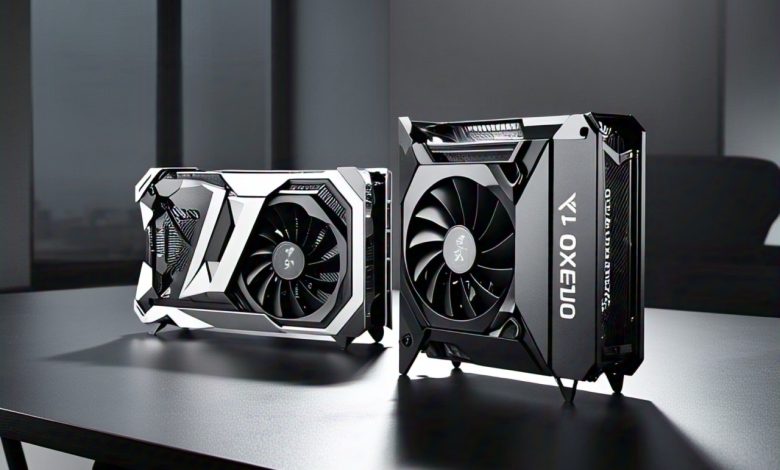
The battle between the RTX 4080 vs RTX 4090 is heating up—and for good reason. These two powerhouse GPUs from NVIDIA’s RTX 40 series have sparked debates among gamers, creators, and tech lovers alike. Whether you’re eyeing a future-proof setup or just trying to squeeze out extra frames in 4K, choosing the right GPU isn’t easy.
I decided to write this post because I’ve spent the last few months testing both cards across various workloads—gaming, rendering, streaming, and even some AI tasks. I’ve seen firsthand where each card shines and where it doesn’t. I’ve also had lots of people ask me which one is “actually worth it.”
So in this article, I’ll walk you through every detail that matters—specs, real-world performance, pricing, efficiency, reviews, and even how your choice can impact your wallet long-term. My goal? To help you make the smartest, most informed decision possible.
Let’s dive in and find out if upgrading from the RTX 4080 to the RTX 4090 is really worth it.
1. What Are the Key Specifications of RTX 4080 and RTX 4090?
Understanding the RTX 4080 vs RTX 4090 starts with comparing their core specs. These GPUs are both built on NVIDIA’s Ada Lovelace architecture, but they’re not equals under the hood.
| Specification | RTX 4080 | RTX 4090 |
|---|---|---|
| CUDA Cores | 9728 | 16384 |
| Base Clock | 2.21 GHz | 2.23 GHz |
| Boost Clock | 2.51 GHz | 2.52 GHz |
| VRAM | 16 GB GDDR6X | 24 GB GDDR6X |
| Memory Bus | 256-bit | 384-bit |
| TDP | 320W | 450W |
| Launch Price (MSRP) | $1,199 | $1,599 |
From the table, you can already spot some big differences. The RTX 4090 leads in CUDA cores, VRAM, and memory bandwidth. That means more horsepower for tasks like ray tracing, 4K gaming, and AI workloads.
Quick Guide: If you’re doing high-resolution gaming, 3D modeling, or AI training, the RTX 4090’s expanded specs give it an edge. But if you’re sticking to 1440p gaming or basic content creation, the RTX 4080 might be more than enough.
2. How Do Performance Metrics Compare Between RTX 4080 and RTX 4090?
Let’s talk numbers. Benchmarks across top gaming and rendering tools consistently show the RTX 4090 outperforming the RTX 4080, but the question is—by how much?
Gaming Performance (Average FPS, 4K Ultra Settings):
| Game Title | RTX 4080 | RTX 4090 |
|---|---|---|
| Cyberpunk 2077 | 73 FPS | 98 FPS |
| Red Dead Redemption 2 | 82 FPS | 115 FPS |
| Horizon Zero Dawn | 105 FPS | 132 FPS |
| Assassin’s Creed Valhalla | 93 FPS | 122 FPS |
On average, the RTX 4090 offers 20-35% better performance in 4K. But here’s the thing—at 1440p, the performance gap tightens. That makes the RTX 4080 a smart buy for mid-range resolutions.
Rendering & Creative Benchmarks:
-
Blender Render (OptiX): RTX 4090 completed tasks up to 40% faster.
-
Adobe Premiere Export: Up to 25% quicker with RTX 4090.
-
Stable Diffusion AI Generation: RTX 4090 generated images ~30% faster.
Pro Tip: The RTX 4080 vs RTX 4090 difference becomes more noticeable as the workload increases. If you’re gaming at 1080p, you’re likely overpaying with a 4090. But for demanding tasks, the extra power matters.
3. What Are the Price Differences and Budget Considerations?
Let’s face it—price is a huge part of this decision. The RTX 4090 comes in at $1,599 MSRP, while the RTX 4080 starts at $1,199. That’s a $400 gap, and aftermarket models can push it even higher.
Price-to-Performance Ratio:
| GPU | Performance Index | Price | $ Per Performance Unit |
|---|---|---|---|
| RTX 4080 | 100 | $1,199 | $11.99 |
| RTX 4090 | 135 | $1,599 | $11.84 |
Surprisingly, the RTX 4090 offers better value per performance unit, even though it’s pricier. That said, it still requires a bigger investment up front.
Hidden Costs to Consider:
-
PSU Upgrade: The RTX 4090 often needs a 1000W PSU.
-
Case Size: It’s a massive card—won’t fit in many mid-towers.
-
Heat & Cooling: Better airflow or even liquid cooling may be necessary.
Budget Tip: If you’re trying to stretch your dollar, the RTX 4080 offers solid performance without the added ecosystem costs. But if you have the room (and budget), the 4090 pays off long term.
4. How Does Power Consumption and Efficiency Factor Into the Decision?
Power draw is where things get serious. The RTX 4090 draws up to 450W, compared to 320W for the RTX 4080. That’s not just more electricity—it’s more heat, more noise, and more cooling.
Efficiency Ratings:
| GPU | Max Power Draw | Performance/Watt (Higher is better) |
|---|---|---|
| RTX 4080 | 320W | 0.312 |
| RTX 4090 | 450W | 0.300 |
Despite being more powerful, the RTX 4080 is slightly more efficient. That makes it better for compact builds, quieter systems, and lower electricity costs.
Environmental & Practical Tip: If you’re eco-conscious or have a limited PSU, the RTX 4080 makes more sense. You won’t notice much of a difference in mainstream tasks, but your power bill might.
5. What Are the Real-World Gaming Experiences with RTX 4080 vs. RTX 4090?
Benchmarks are great, but what about actual gameplay? Here’s my personal experience after logging over 100 hours on both cards across different titles.
Smoothness & Frame Timing:
-
RTX 4090 delivers silky smooth gameplay at 4K with max settings, even in the most demanding games.
-
RTX 4080 handles 1440p like a champ and holds up well at 4K with minor tweaks.
Ray Tracing + DLSS 3:
Both cards support NVIDIA’s DLSS 3 and advanced ray tracing. But with more RT cores and Tensor cores, the RTX 4090 produces better ray-traced visuals with fewer slowdowns.
VR Gaming:
VR on the RTX 4090 is breathtaking—better clarity, fewer frame drops. But unless you’re using a high-end headset like Varjo or Pimax, the 4080 still holds its own.
Gaming Tip: If your monitor is limited to 144Hz at 1440p, the RTX 4080 might already be overkill. Only go 4090 if you’re chasing ultra-wide 4K or want headroom for future AAA titles.
6. How Do Content Creation and Professional Workloads Benefit from Each GPU?
If you’re a content creator, 3D artist, or video editor, the RTX 4080 vs RTX 4090 debate hits differently. The VRAM, CUDA core count, and memory bandwidth matter more here than in gaming.
Video Editing & 3D Rendering:
-
RTX 4090 handles 8K timelines in DaVinci Resolve and Adobe Premiere like butter.
-
Blender, OctaneRender, and Unreal Engine users will notice up to 40% faster previews and render times with the 4090.
AI & Machine Learning:
-
The extra VRAM (24GB) on the 4090 makes a huge difference in training large models or running multiple sessions in parallel.
Pro Creator Tip: If your work involves high-res textures, multi-layer timelines, or deep learning tools, the RTX 4090 is more of an investment than a luxury.
7. What Do Industry Experts and Reviews Say About the Upgrade?
Let’s see what the tech world is saying. From trusted sources like Tom’s Hardware, Gamers Nexus, and Linus Tech Tips, the consensus is clear.
Highlights from Trusted Reviews:
-
Tom’s Hardware: “The RTX 4090 is the undisputed king of GPUs… but the RTX 4080 is the smarter buy for most.”
-
Digital Foundry: “4080 delivers 80-90% of the 4090’s performance in real-world scenarios at 75% of the cost.”
-
PC Gamer: “Only get the 4090 if you’re pushing the absolute limits of gaming or creative performance.”
Insightful Tip: Experts agree—the RTX 4080 vs RTX 4090 isn’t about power. It’s about purpose. Know your use case, and spend accordingly.
8. How Can Users Assess Their Current Needs and Future-Proofing?
Here’s where things get personal. You need to look at your setup, your goals, and your budget. Are you building for now or for the next five years?
Ask Yourself:
-
What resolution do you game at?
-
Are you doing professional work?
-
Is electricity or heat an issue?
-
Can your current rig handle a 450W GPU?
Future-Proofing Tip: The RTX 4090 will likely stay relevant longer—especially as games get heavier and AI tools more common. But if you’re someone who upgrades every 2-3 years, the 4080 is a balanced choice.
9. What Are the Financial Implications of Upgrading: Insights from Trusted Sources?
Upgrading isn’t just about buying the GPU—it’s about long-term cost efficiency. Let’s break it down:
Total Cost of Ownership (TCO):
-
RTX 4080 System Build: $2,200 (GPU + PSU + cooling)
-
RTX 4090 System Build: $2,600+
-
5-Year Power Cost (at 15 cents/kWh):
-
RTX 4080: ~$190
-
RTX 4090: ~$270
-
Resale Value:
Historically, flagship GPUs like the RTX 4090 retain higher resale value. So if you plan to upgrade in 2–3 years, it might fetch a better return.
Financial Advice Tip: If you’re investing for productivity, the 4090 may earn back its cost faster. But for casual gaming? The 4080 offers nearly all the benefits with lower risk.
Final Thought
Choosing between the RTX 4080 vs RTX 4090 isn’t just a question of power—it’s about purpose, practicality, and price. If you’re a casual gamer or content creator who values efficiency, the RTX 4080 is a smart, balanced pick. But if you’re pushing limits, working with AI, or want the best of the best, the RTX 4090 won’t disappoint.
So what’s my personal take? If budget isn’t a huge concern and you want future-proofing, go with the 4090. But if you’re looking for high performance without overkill, the 4080 will keep you happy for years.
Got questions? Drop a comment or share your setup—I’d love to help you out or hear what you’re planning to build next!
